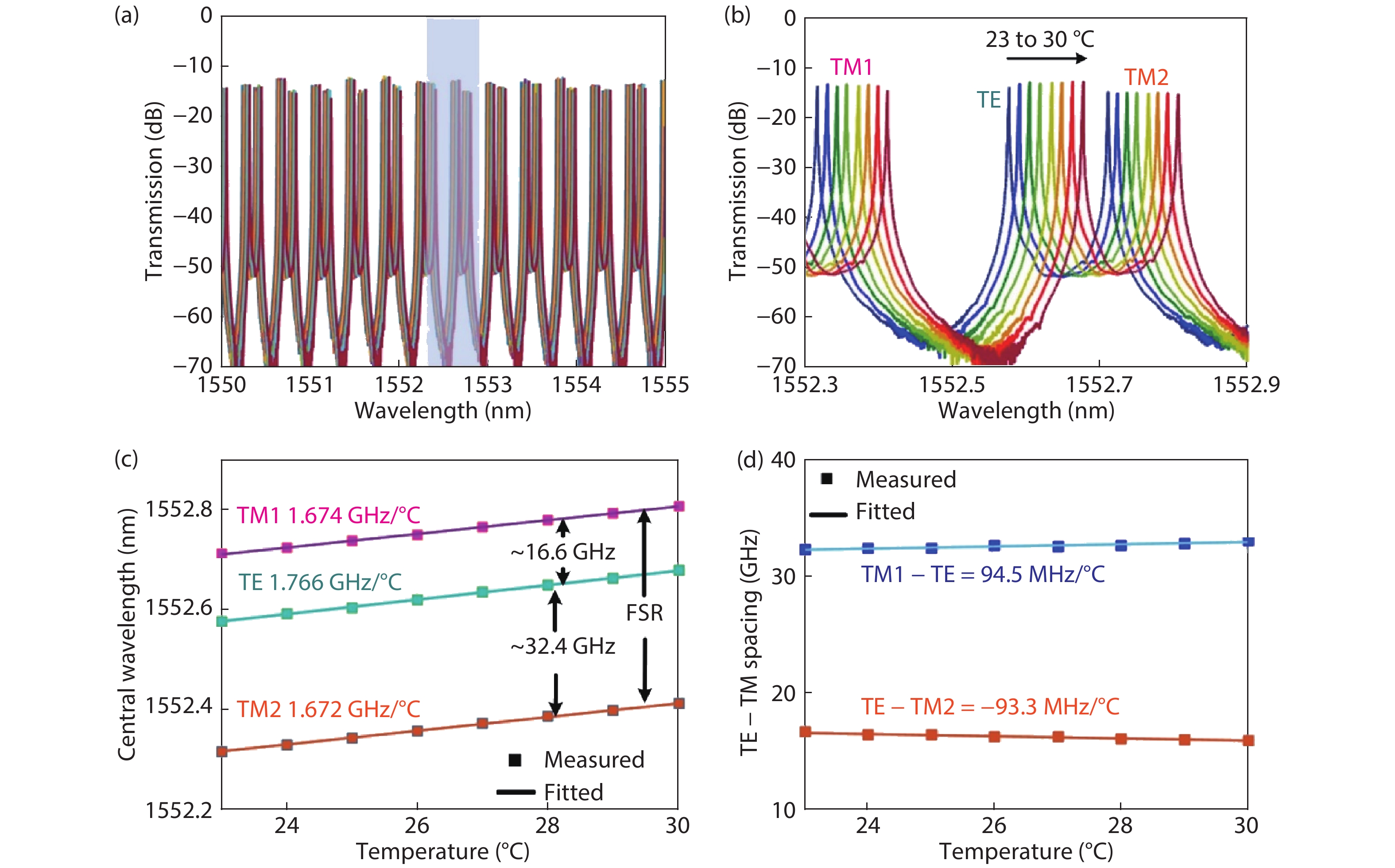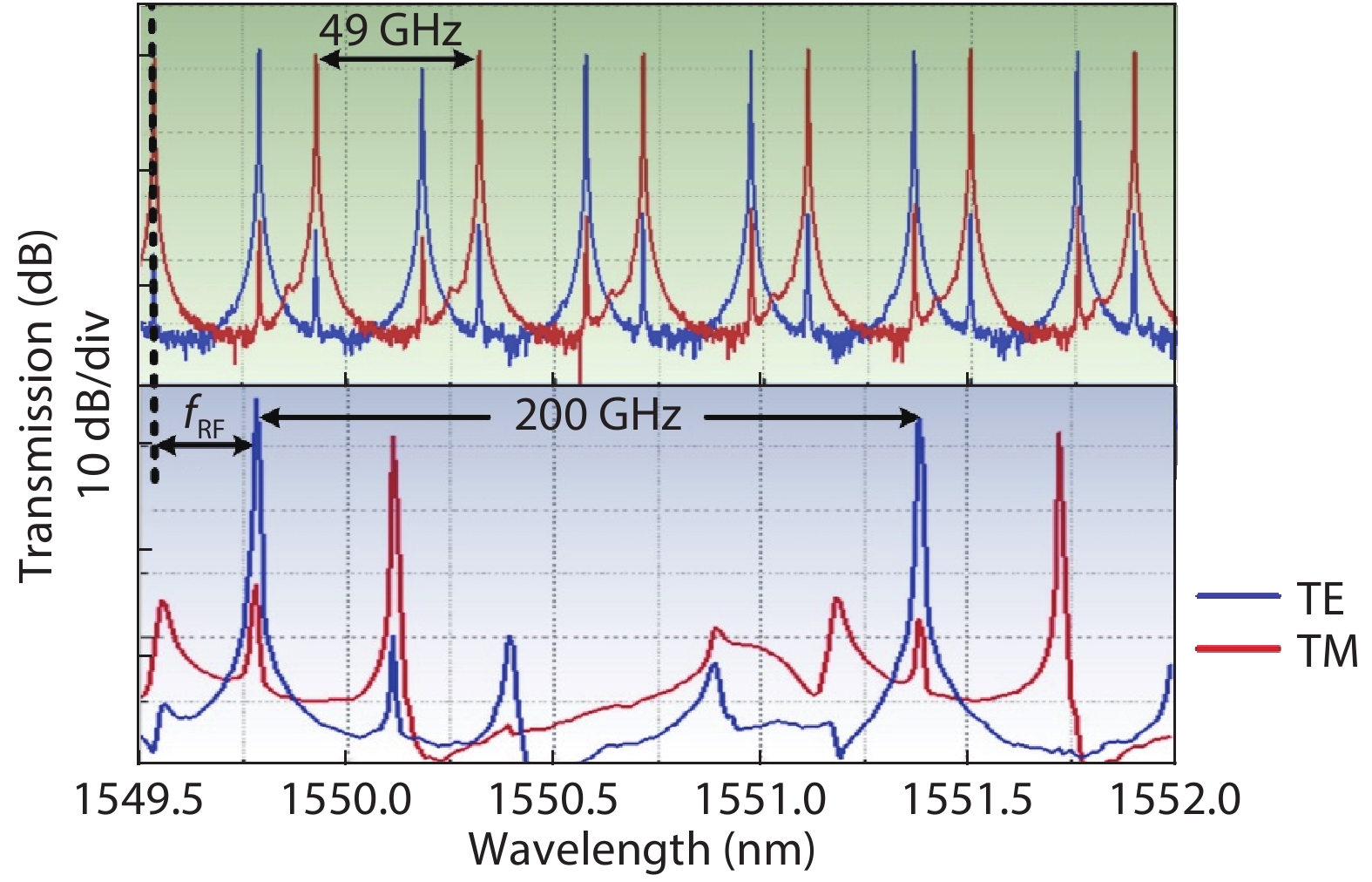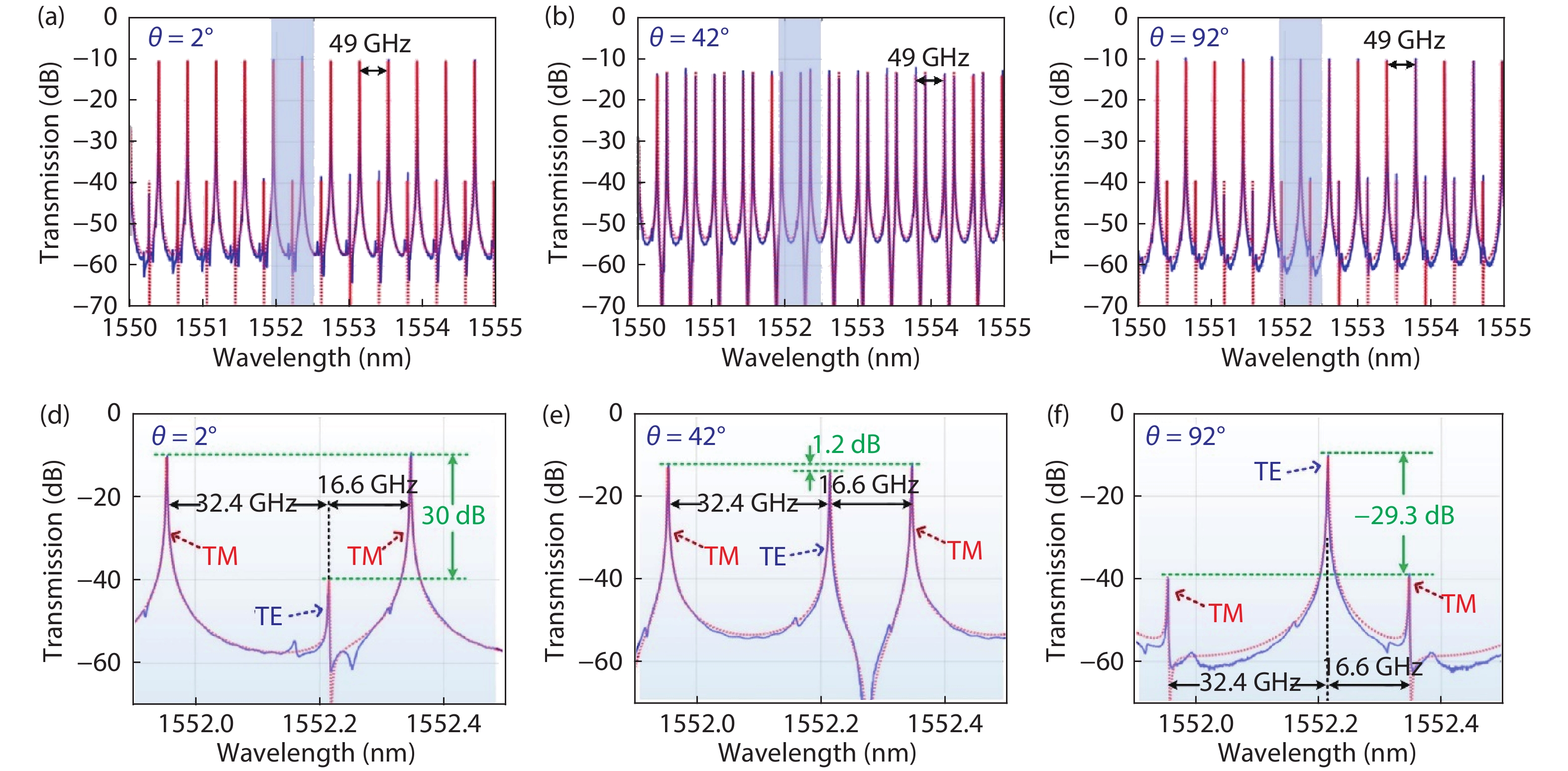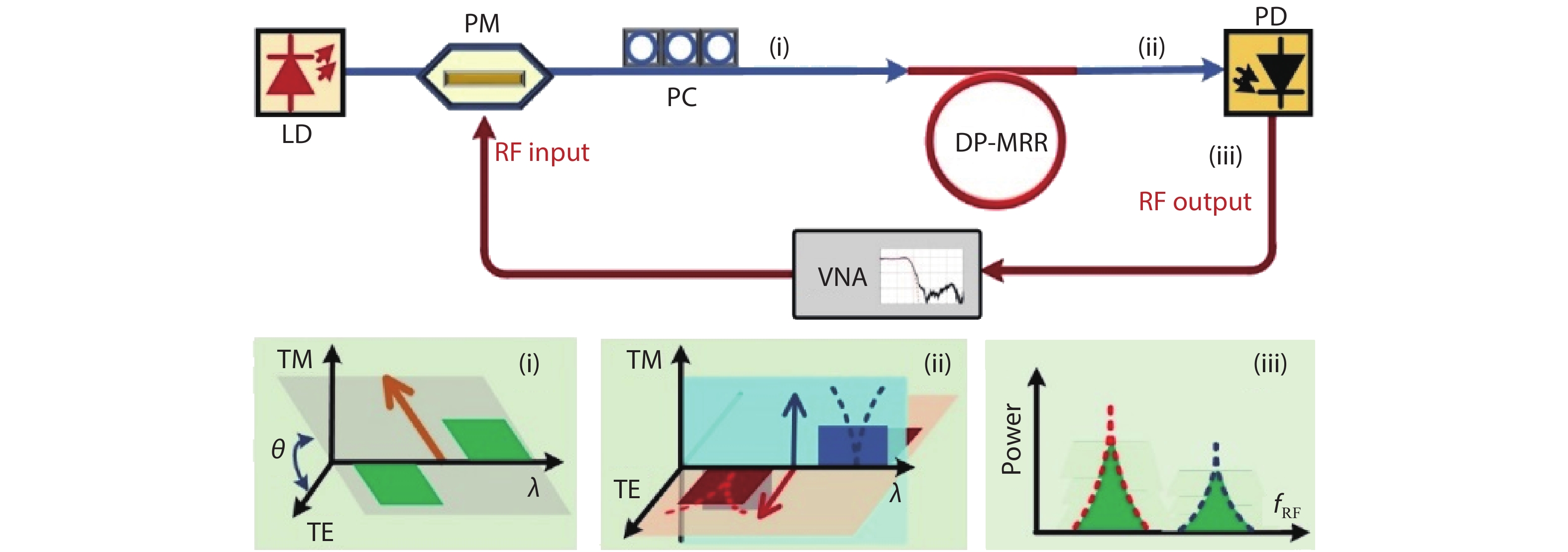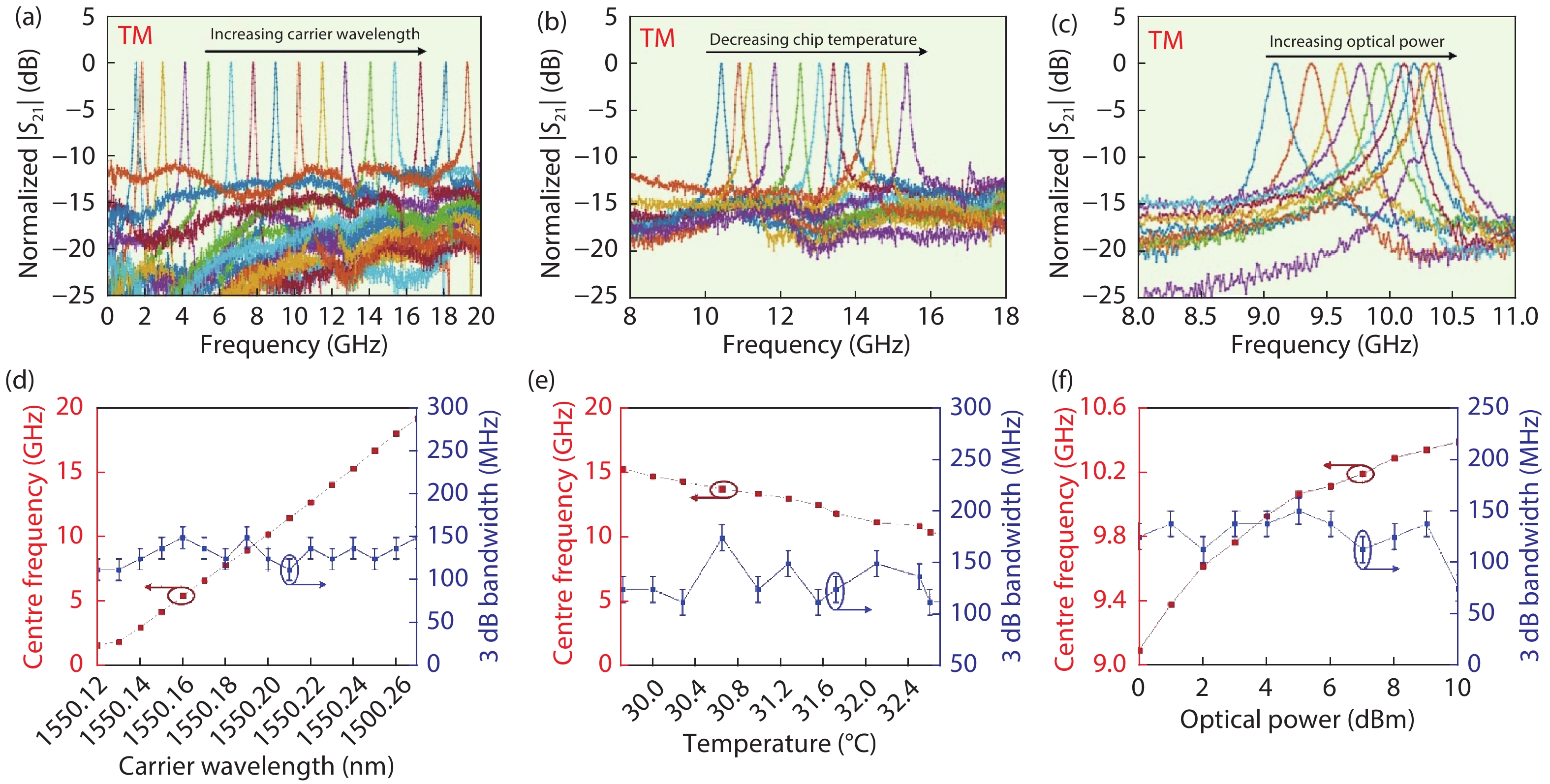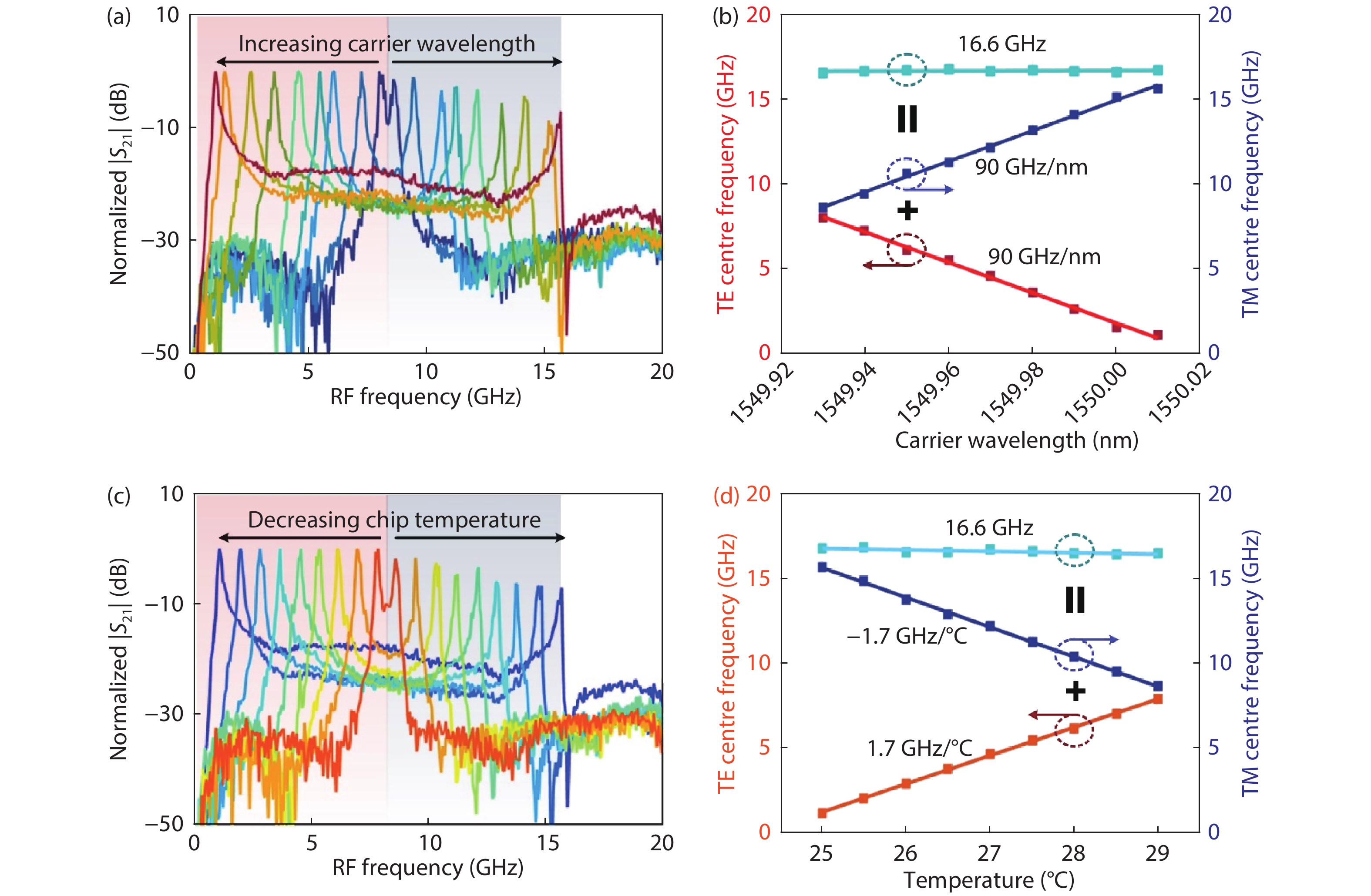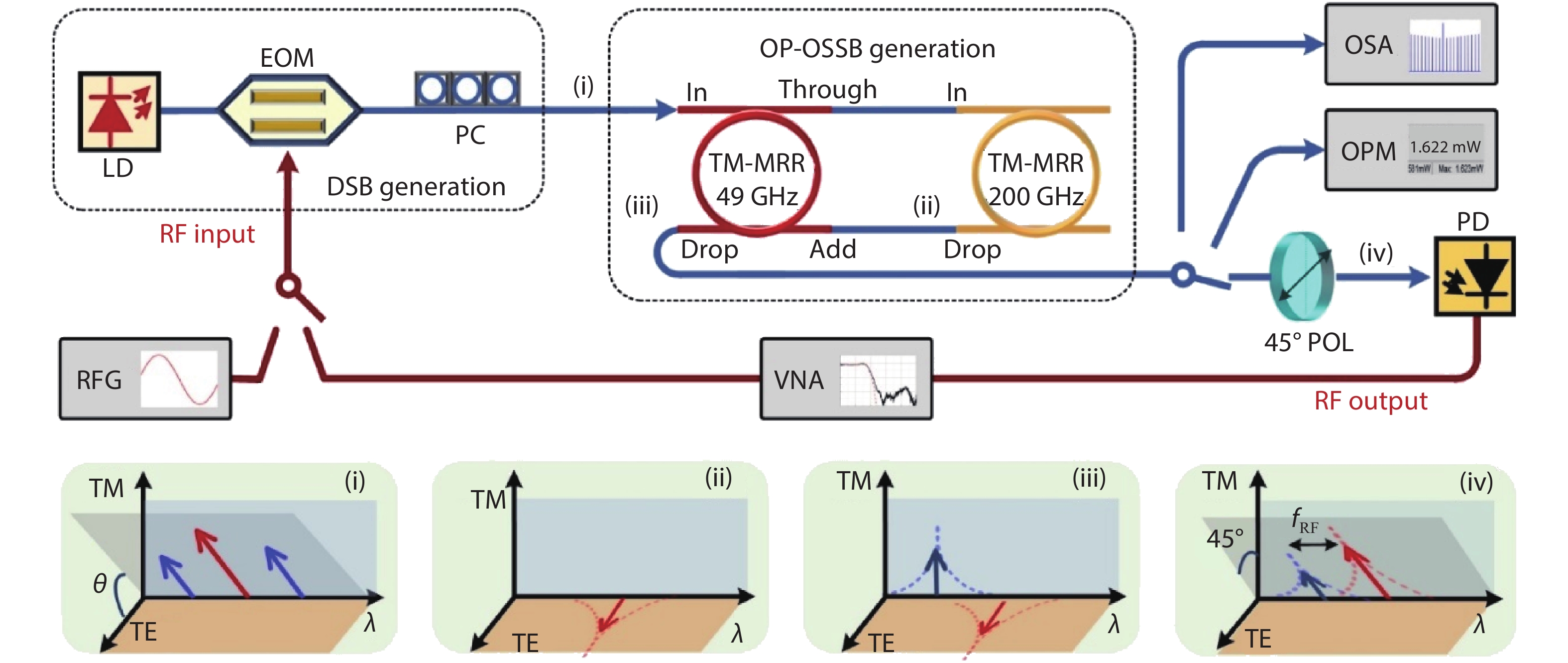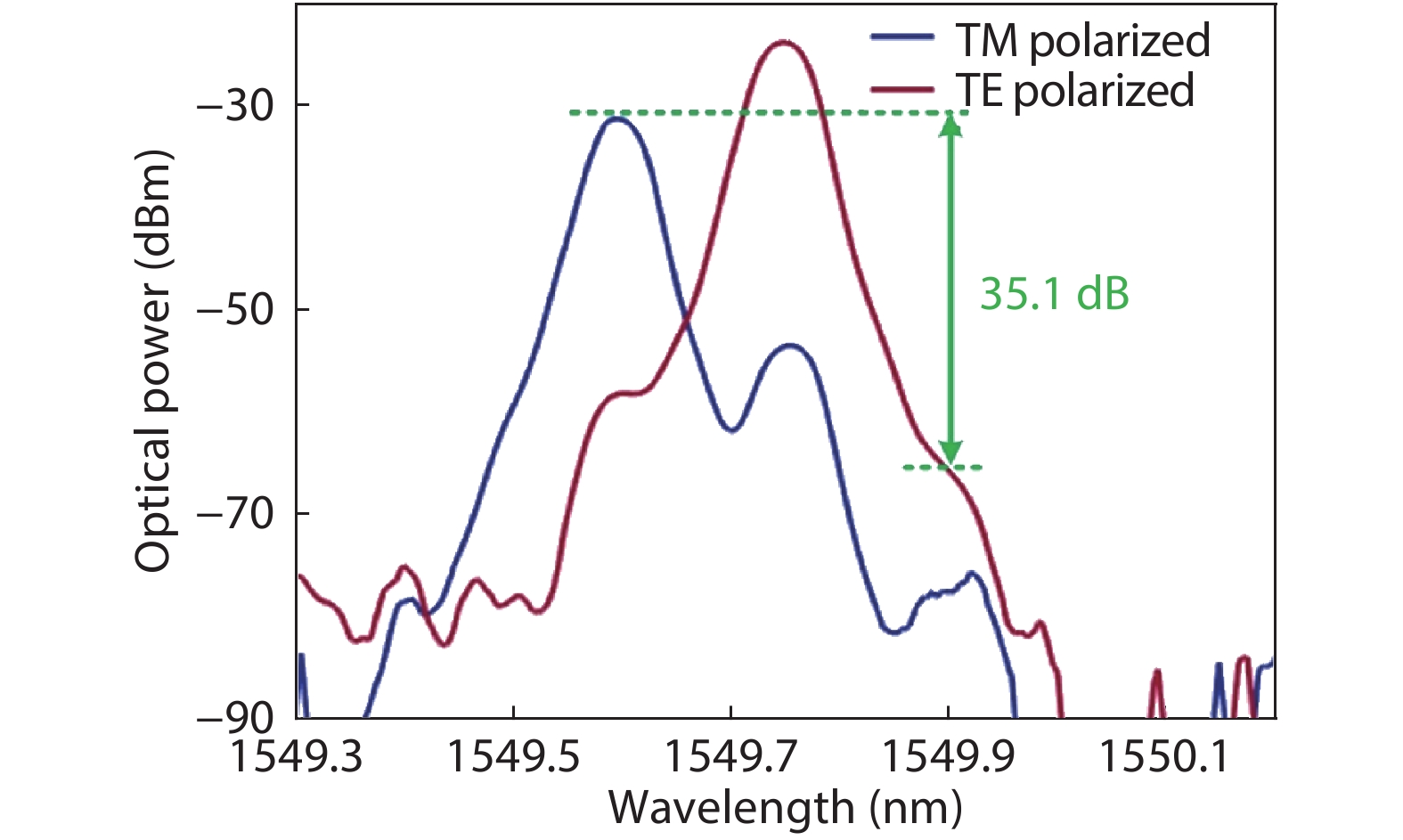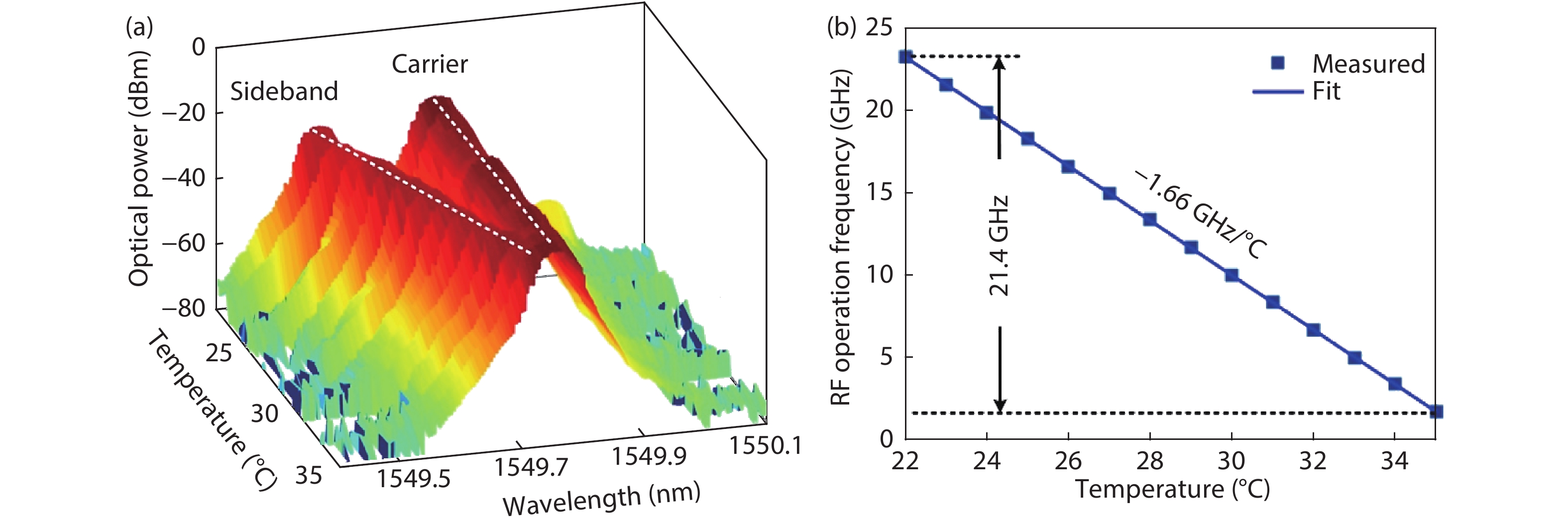| Citation: |
Mengxi Tan, Xingyuan Xu, Jiayang Wu, Thach G. Nguyen, Sai T. Chu, Brent E. Little, Arnan Mitchell, Roberto Morandotti, David J. Moss. Orthogonally polarized RF optical single sideband generation with integrated ring resonators[J]. Journal of Semiconductors, 2021, 42(4): 041305. doi: 10.1088/1674-4926/42/4/041305
****
M X Tan, X Y Xu, J Y Wu, T G Nguyen, S T Chu, B E Little, A Mitchell, R Morandotti, D J Moss, Orthogonally polarized RF optical single sideband generation with integrated ring resonators[J]. J. Semicond., 2021, 42(4): 041305. doi: 10.1088/1674-4926/42/4/041305.
|
Orthogonally polarized RF optical single sideband generation with integrated ring resonators
DOI: 10.1088/1674-4926/42/4/041305
More Information
-
Abstract
We review recent work on narrowband orthogonally polarized optical RF single sideband generators as well as dual-channel equalization, both based on high-Q integrated ring resonators. The devices operate in the optical telecommunications C-band and enable RF operation over a range of either fixed or thermally tuneable frequencies. They operate via TE/TM mode birefringence in the resonator. We achieve a very large dynamic tuning range of over 55 dB for both the optical carrier-to-sideband ratio and the dual-channel RF equalization for both the fixed and tunable devices.-
Keywords:
- microwave photonics,
- micro-ring resonators,
- radio frequency
-
References
[1] Capmany J, Novak D. Microwave photonics combines two worlds. Nat Photonics, 2007, 1, 319 doi: 10.1038/nphoton.2007.89[2] Yao J P. Microwave photonics. J Lightwave Technol, 2009, 27, 314 doi: 10.1109/JLT.2008.2009551[3] Xu K, Wang R X, Dai Y T, et al. Microwave photonics: Radio-over-fiber links, systems, and applications. Photon Res, 2014, 2, B54 doi: 10.1364/PRJ.2.000B54[4] Gliese U, Norskov S, Nielsen T N. Chromatic dispersion in fiber-optic microwave and millimeter-wave links. IEEE Trans Microw Theory Tech, 1996, 44, 1716 doi: 10.1109/22.538964[5] Zhang Y M, Zhang F Z, Pan S L. Optical single sideband modulation with tunable optical carrier-to-sideband ratio. IEEE Photonics Technol Lett, 2014, 26, 653 doi: 10.1109/LPT.2014.2301893[6] Blais S R, Yao J P. Optical single sideband modulation using an ultranarrow dual-transmission-band fiber Bragg grating. IEEE Photonics Technol Lett, 2006, 18, 2230 doi: 10.1109/LPT.2006.884235[7] Feng D Q, Sun J Q. Optical single sideband modulation based on a high-order birefringent filter using cascaded Solc-Sagnac and Lyot-Sagnac loops. Opt Lett, 2016, 41, 3659 doi: 10.1364/OL.41.003659[8] Shen Y C, Zhang X M, Chen K S. Optical single sideband modulation of 11-GHz RoF system using stimulated Brillouin scattering. IEEE Photonics Technol Lett, 2005, 17, 1277 doi: 10.1109/LPT.2005.846491[9] Hraimel B, Zhang X P, Pei Y Q, et al. Optical single-sideband modulation with tunable optical carrier to sideband ratio in radio over fiber systems. J Lightwave Technol, 2011, 29, 775 doi: 10.1109/JLT.2011.2108261[10] Xue M, Pan S L, Zhao Y J. Optical single-sideband modulation based on a dual-drive MZM and a 120° hybrid coupler. J Lightwave Technol, 2014, 32, 3317 doi: 10.1109/JLT.2014.2344853[11] Xu X Y, Wu J Y, Nguyen T G, et al. Photonic microwave true time delays for phased array antennas using a 49 GHz FSR integrated optical micro-comb source. Photon Res, 2018, 6, B30 doi: 10.1364/PRJ.6.000B30[12] Xue X X, Xuan Y, Kim H J, et al. Programmable single-bandpass photonic RF filter based on kerr comb from a microring. J Lightwave Technol, 2014, 32, 3557 doi: 10.1109/JLT.2014.2312359[13] Xu X Y, Wu J Y, Nguyen T G, et al. Advanced RF and microwave functions based on an integrated optical frequency comb source. Opt Express, 2018, 26, 2569 doi: 10.1364/OE.26.002569[14] Nguyen T G, Shoeiby M, Chu S T, et al. Integrated frequency comb source based Hilbert transformer for wideband microwave photonic phase analysis. Opt Express, 2015, 23, 22087 doi: 10.1364/OE.23.022087[15] Xu X Y, Wu J Y, Nguyen T G, et al. Broadband RF channelizer based on an integrated optical frequency kerr comb source. J Lightwave Technol, 2018, 36, 4519 doi: 10.1109/JLT.2018.2819172[16] Ferrera M, Reimer C, Pasquazi A, et al. CMOS compatible integrated all-optical radio frequency spectrum analyzer. Opt Express, 2014, 22, 21488 doi: 10.1364/OE.22.021488[17] Corcoran B, Vo T D, Pelusi M D, et al. Silicon nanowire based radio-frequency spectrum analyzer. Opt Express, 2010, 18, 20190 doi: 10.1364/OE.18.020190[18] Pelusi M, Luan F, Vo T D, et al. Photonic-chip-based radio-frequency spectrum analyser with terahertz bandwidth. Nat Photonics, 2009, 3, 139 doi: 10.1038/nphoton.2009.1[19] Xu X Y, Wu J Y, Tan M X, et al. Orthogonally polarized RF optical single sideband generation and dual-channel equalization based on an integrated microring resonator. J Lightwave Technol, 2018, 36, 4808 doi: 10.1109/JLT.2018.2863704[20] Xu X, Wu J, Nguyen T G, et al. Continuously tunable orthogonally polarized optical RF single sideband generator and equalizer based on an integrated micro-ring resonator. J Opt, 2018, 20, 115701 doi: 10.1088/2040-8986/aae3fe[21] Tan M X, Xu X Y, Corcoran B, et al. Microwave and RF photonic fractional Hilbert transformer based on a 50 GHz Kerr micro-comb. J Lightwave Technol, 2019, 37, 6097 doi: 10.1109/JLT.2019.2946606[22] Xu X Y, Tan M X, Wu J Y, et al. Advanced adaptive photonic RF filters with 80 taps based on an integrated optical micro-comb source. J Lightwave Technol, 2019, 37, 1288 doi: 10.1109/JLT.2019.2892158[23] Xu X Y, Tan M X, Wu J Y, et al. High performance RF filters via bandwidth scaling with Kerr micro-combs. APL Photonics, 2019, 4, 026102 doi: 10.1063/1.5080246[24] Xu X Y, Tan M X, Wu J Y, et al. Microcomb-based photonic RF signal processing. IEEE Photonics Technol Lett, 2019, 31, 1854 doi: 10.1109/LPT.2019.2940497[25] Xu X Y, Tan M X, Wu J, et al. Photonic RF phase-encoded signal generation with a microcomb source. J Lightwave Technol, 2020, 38, 1722 doi: 10.1109/JLT.2019.2958564[26] Xu X Y, Wu J Y, Tan M X, et al. Broadband microwave frequency conversion based on an integrated optical micro-comb source. J Lightwave Technol, 2020, 38, 332 doi: 10.1109/JLT.2019.2930466[27] Tan M X, Xu X Y, Corcoran B, et al. RF and microwave fractional differentiator based on photonics. IEEE Trans Circuits Syst II, 2020, 67, 2767 doi: 10.1109/TCSII.2020.2965158[28] Xu X Y, Tan M X, Corcoran B, et al. Photonic perceptron based on a kerr microcomb for high-speed, scalable, optical neural networks. Laser Photonics Rev, 2020, 14, 2000070 doi: 10.1002/lpor.202000070[29] Tan M X, Xu X Y, Wu J Y, et al. Photonic RF and microwave filters based on 49 GHz and 200 GHz Kerr microcombs. Opt Commun, 2020, 465, 125563 doi: 10.1016/j.optcom.2020.125563[30] Xu X Y, Tan M X, Wu J Y, et al. Photonic RF and microwave integrator based on a transversal filter with soliton crystal microcombs. IEEE Trans Circuits Syst II, 2020, 67, 3582 doi: 10.1109/TCSII.2020.2995682[31] Xu X Y, Tan M X, Wu J Y, et al. Broadband photonic RF channelizer with 92 channels based on a soliton crystal microcomb. J Lightwave Technol, 2020, 38, 5116 doi: 10.1109/JLT.2020.2997699[32] Tan M, Xu X, Boes A, et al. Photonic RF arbitrary waveform generator based on a soliton crystal micro-comb source. J Lightwave Technol, 2020, 38, 6221 doi: 10.1109/JLT.2020.3009655[33] Corcoran B, Tan M X, Xu X Y, et al. Ultra-dense optical data transmission over standard fibre with a single chip source. Nat Commun, 2020, 11, 2568 doi: 10.1038/s41467-020-16265-x[34] Wu J, Xu X, Nguyen T G, et al. RF photonics: An optical microcombs’ perspective. IEEE J Sel Top Quantum, 2018, 24, 1 doi: 10.1109/JSTQE.2018.2805814[35] Xu X Y, Wu J Y, Shoeiby M, et al. Reconfigurable broadband microwave photonic intensity differentiator based on an integrated optical frequency comb source. APL Photonics, 2017, 2, 096104 doi: 10.1063/1.4989871[36] Tan M, Xu X, Wu J, et al. RF and microwave photonic temporal signal processing with Kerr micro-combs. Adv Phys X, 2021, 6, 1838946 doi: 10.1080/23746149.2020.1838946[37] Xu X, Tan M, Corcoran B, et al. 11 TOPS photonic convolutional accelerator for optical neural networks. Nature, 2021, 589, 44 doi: 10.1038/s41586-020-03063-0[38] Pan S L, Zhang Y M. Tunable and wideband microwave photonic phase shifter based on a single-sideband polarization modulator and a polarizer. Opt Lett, 2012, 37, 4483 doi: 10.1364/OL.37.004483[39] Wang L, Li W, Wang H, et al. Photonic generation of phase coded microwave pulses using cascaded polarization modulators. IEEE Photonics Technol Lett, 2013, 25, 678 doi: 10.1109/LPT.2013.2249060[40] Wang L, Li W, Zheng J, et al. High-speed microwave photonic switch for millimeter-wave ultra-wideband signal generation. Opt Lett, 2013, 38, 579 doi: 10.1364/OL.38.000579[41] Li Z H, Yu C Y, Dong Y, et al. Linear photonic radio frequency phase shifter using a differential-group-delay element and an optical phase modulator. Opt Lett, 2010, 35, 1881 doi: 10.1364/OL.35.001881[42] Vidal B, Mengual T, Ibanez-Lopez C, et al. Optical beamforming network based on fiber-optical delay lines and spatial light modulators for large antenna arrays. IEEE Photonics Technol Lett, 2006, 18, 2590 doi: 10.1109/LPT.2006.887347[43] Zheng J Y, Wang L X, Dong Z, et al. Orthogonal single-sideband signal generation using improved Sagnac-loop-based modulator. IEEE Photonics Technol Lett, 2014, 26, 2229 doi: 10.1109/LPT.2014.2351402[44] Wang W, Liu J, Mei H, et al. Phase-coherent orthogonally polarized optical single sideband modulation with arbitrarily tunable optical carrier-to-sideband ratio. Opt Express, 2016, 24, 388 doi: 10.1364/OE.24.000388[45] Zhang Y M, Zhang F Z, Pan S L. Optical single sideband polarization modulation for radio-over-fiber system and microwave photonic signal processing. Photon Res, 2014, 2, B80 doi: 10.1364/PRJ.2.000B80[46] Campillo A L. Orthogonally polarized single sideband modulator. Opt Lett, 2007, 32, 3152 doi: 10.1364/OL.32.003152[47] Sagues M, Loayssa A. Orthogonally polarized optical single sideband modulation for microwave photonics processing using stimulated Brillouin scattering. Opt Express, 2010, 18, 22906 doi: 10.1364/OE.18.022906[48] Li W, Zhu N, Wang L. Perfectly orthogonal optical single-sideband signal generation based on stimulated Brillouin scattering. IEEE Photonics Technol Lett, 2012, 24, 751 doi: 10.1109/LPT.2012.2187780[49] Nebuloni L, Orsenigo G. Microwave power module for space applications. IEEE Trans Electron Devices, 2001, 48, 88 doi: 10.1109/16.892173[50] Wang H, Yan B, Wang Z G, et al. A broadband microwave gain equalizer. PIER Lett, 2012, 33, 63 doi: 10.2528/PIERL12052309[51] Wang S X, Wang Y F, Zhang D W, et al. Design of tunable equalizers using multilayered half mode substrate integrated waveguide structures added absorbing Pillars. Adv Mater Sci Eng, 2015, 2015, 1 doi: 10.1155/2015/645638[52] Zhang D W, Liu Q, Dongfang Z, et al. A gain equalizer based on dual-mode circular substrate integrated waveguide resonators. IEEE Microw Wirel Components Lett, 2017, 27, 539 doi: 10.1109/LMWC.2017.2701315[53] Marpaung D, Roeloffzen C, Heideman R, et al. Integrated microwave photonics. Laser Photonics Rev, 2013, 7, 506 doi: 10.1002/lpor.201200032[54] Liu W L, Li M, Guzzon R S, et al. A fully reconfigurable photonic integrated signal processor. Nat Photonics, 2016, 10, 190 doi: 10.1038/nphoton.2015.281[55] Moss D J, Morandotti R, Gaeta A L, et al. New CMOS-compatible platforms based on silicon nitride and Hydex for nonlinear optics. Nat Photonics, 2013, 7, 597 doi: 10.1038/nphoton.2013.183[56] Ferrera M, Razzari L, Duchesne D, et al. Low-power continuous-wave nonlinear optics in doped silica glass integrated waveguide structures. Nat Photonics, 2008, 2, 737 doi: 10.1038/nphoton.2008.228[57] Peccianti M, Ferrera M, Razzari L, et al. Subpicosecond optical pulse compression via an integrated nonlinear chirper. Opt Express, 2010, 18, 7625 doi: 10.1364/OE.18.007625[58] Razzari L, Duchesne D, Ferrera M, et al. CMOS-compatible integrated optical hyper-parametric oscillator. Nat Photonics, 2010, 4, 41 doi: 10.1038/nphoton.2009.236[59] Pasquazi A, Peccianti M, Razzari L, et al. Micro-combs: A novel generation of optical sources. Phys Rep, 2018, 729, 1 doi: 10.1016/j.physrep.2017.08.004[60] Caspani L, Xiong C, Eggleton B, et al. On-chip sources of quantum correlated and entangled photons. Light: Sci Appl, 2017, 6, e17100 doi: 10.1038/lsa.2017.100[61] Kues M, Reimer C, Wetzel B, et al. Passively mode-locked laser with an ultra-narrow spectral width. Nat Photonics, 2017, 11, 159 doi: 10.1038/nphoton.2016.271[62] Pasquazi A, Peccianti M, Little B E, et al. Stable, dual mode, high repetition rate mode-locked laser based on a microring resonator. Opt Express, 2012, 20, 27355 doi: 10.1364/OE.20.027355[63] Pasquazi A, Caspani L, Peccianti M, et al. Self-locked optical parametric oscillation in a CMOS compatible microring resonator: A route to robust optical frequency comb generation on a chip. Opt Express, 2013, 21, 13333 doi: 10.1364/OE.21.013333[64] Reimer C, Sciara S, Roztocki P, et al. High-dimensional one-way quantum processing implemented on d-level cluster states. Nat Phys, 2019, 15, 148 doi: 10.1038/s41567-018-0347-x[65] Kues M, Reimer C, Lukens J M, et al. Quantum optical microcombs. Nat Photonics, 2019, 13, 170 doi: 10.1038/s41566-019-0363-0[66] Pasquazi A, Peccianti M, Park Y, et al. Sub-picosecond phase-sensitive optical pulse characterization on a chip. Nat Photonics, 2011, 5, 618 doi: 10.1038/nphoton.2011.199[67] Bao H L, Cooper A, Rowley M, et al. Laser cavity-soliton microcombs. Nat Photonics, 2019, 13, 384 doi: 10.1038/s41566-019-0379-5[68] Reimer C, Kues M, Caspani L, et al. Cross-polarized photon-pair generation and bi-chromatically pumped optical parametric oscillation on a chip. Nat Commun, 2015, 6, 8236 doi: 10.1038/ncomms9236[69] Caspani L, Reimer C, Kues M, et al. Multifrequency sources of quantum correlated photon pairs on-chip: A path toward integrated quantum frequency combs. Nanophotonics, 2016, 5, 351 doi: 10.1515/nanoph-2016-0029[70] Reimer C, Kues M, Roztocki P, et al. Generation of multiphoton entangled quantum states by means of integrated frequency combs. Science, 2016, 351, 1176 doi: 10.1126/science.aad8532[71] Kues M, Reimer C, Roztocki P, et al. On-chip generation of high-dimensional entangled quantum states and their coherent control. Nature, 2017, 546, 622 doi: 10.1038/nature22986[72] Roztocki P, Kues M, Reimer C, et al. Practical system for the generation of pulsed quantum frequency combs. Opt Express, 2017, 25, 18940 doi: 10.1364/OE.25.018940[73] Levy J S, Gondarenko A, Foster M A, et al. CMOS-compatible multiple-wavelength oscillator for on-chip optical interconnects. Nat Photonics, 2010, 4, 37 doi: 10.1038/nphoton.2009.259[74] Xue X X, Xuan Y, Wang C, et al. Thermal tuning of Kerr frequency combs in silicon nitride microring resonators. Opt Express, 2016, 24, 687 doi: 10.1364/OE.24.000687[75] Pasquazi A, Ahmad R, Rochette M, et al. All-optical wavelength conversion in an integrated ring resonator. Opt Express, 2010, 18, 3858 doi: 10.1364/OE.18.003858[76] Wu J Y, Peng J Z, Liu B Y, et al. Passive silicon photonic devices for microwave photonic signal processing. Opt Commun, 2016, 373, 44 doi: 10.1016/j.optcom.2015.07.045[77] Little B E, Chu S T, Haus H A, et al. Microring resonator channel dropping filters. J Lightwave Technol, 1997, 15, 998 doi: 10.1109/50.588673[78] Little B E, Chu S T, Absil P P, et al. Very high-order microring resonator filters for WDM applications. IEEE Photonics Technol Lett, 2004, 16, 2263 doi: 10.1109/LPT.2004.834525[79] Wu J Y, Moein T, Xu X Y, et al. Advanced photonic filters based on cascaded Sagnac loop reflector resonators in silicon-on-insulator nanowires. APL Photonics, 2018, 3, 046102 doi: 10.1063/1.5025833[80] Wu J Y, Moein T, Xu X Y, et al. Micro-ring resonator quality factor enhancement via an integrated Fabry-Perot cavity. APL Photonics, 2017, 2, 056103 doi: 10.1063/1.4981392[81] Cui N, Zhang X G, Zheng Z B, et al. Two-parameter-SOP and three-parameter-RSOP fiber channels: Problem and solution for polarization demultiplexing using Stokes space. Opt Express, 2018, 26, 21170 doi: 10.1364/OE.26.021170[82] Xu Q F. Lipson M. All-optical logic based on silicon micro-ring resonators. Opt Express, 2007, 15, 924 doi: 10.1364/OE.15.000924[83] Godbole A, Dali P P, Janyani V, et al. All optical scalable logic gates using Si3N4 microring resonators. IEEE J Sel Top Quantum Electron, 2016, 22, 326 doi: 10.1109/JSTQE.2016.2593278[84] Gerislioglu B, Ahmadivand A, Karabiyik M, et al. VO2 -based reconfigurable antenna platform with addressable microheater matrix. Adv Electron Mater, 2017, 3, 1700170 doi: 10.1002/aelm.201700170[85] Akcay C, Parrein P, Rolland J P. Estimation of longitudinal resolution in optical coherence imaging. Appl Opt, 2002, 41, 5256 doi: 10.1364/AO.41.005256[86] Wu J Y, Cao P, Pan T, et al. Compact on-chip 1 × 2 wavelength selective switch based on silicon microring resonator with nested pairs of subrings. Photon Res, 2015, 3, 9 doi: 10.1364/PRJ.3.000009[87] Dutt A, Joshi C, Ji X C, et al. On-chip dual comb source for spectroscopy. arXiv: 1611.07673, 2016 -
Proportional views





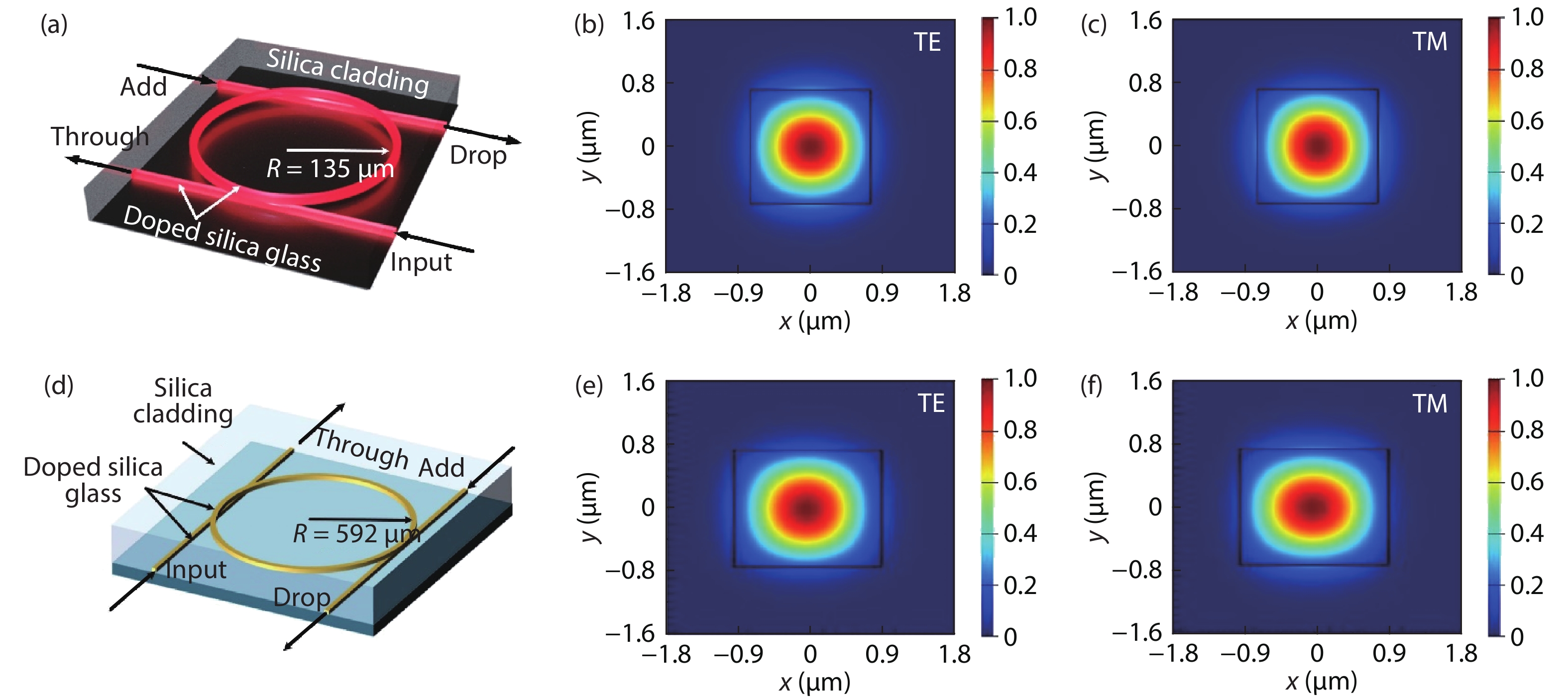
 DownLoad:
DownLoad:

